Physical Address
304 North Cardinal St.
Dorchester Center, MA 02124
Primarily affects young adults aged 20 to 40 years; occasionally seen in children
Presents as a rapidly growing solitary mass; may be painful
Inconsistently associated with recognized previous trauma (10% to 15%)
Can involve any site; flexor aspect of forearm, chest, and back are common sites
Spontaneous regression is expected
Located in the deep dermis or subcutis; occasionally occurs intramuscularly
Round to oval, nodular, well-circumscribed mass; usually smaller than 3 cm
Cut surface may be fibrous, myxoid, or cystic
Usually well circumscribed but occasionally infiltrative
“Tissue culture” appearance with long fascicles of spindled cells with a whorled growth pattern; extravasated red blood cells are a helpful feature ( Figure 17.1 )
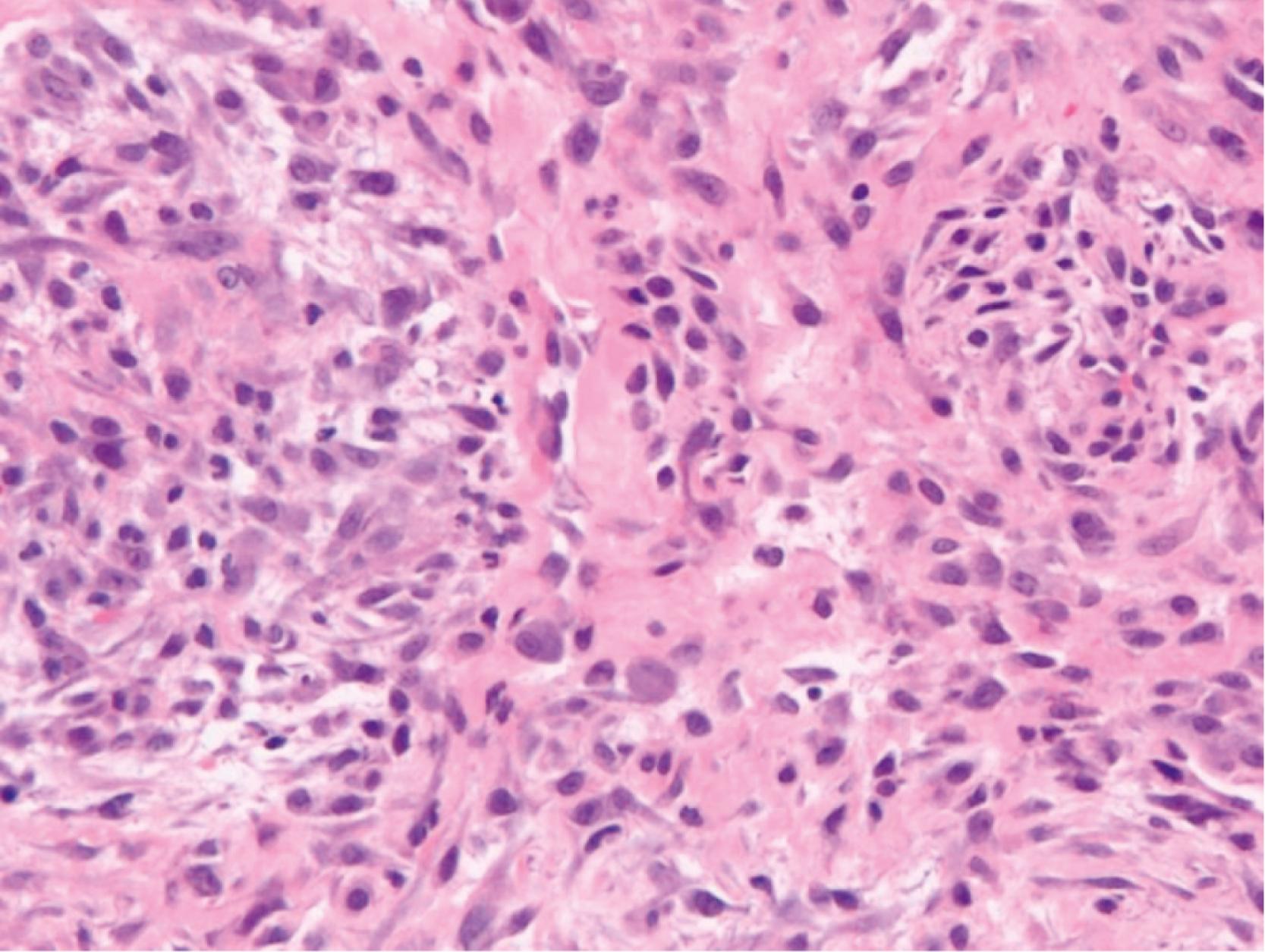
Newer lesions have a loose, feathery collagenous stroma with myxoid or microcystic appearance, whereas older lesions are less cellular and more densely collagenized
Zonal pattern with cellular periphery and loose, feathery center that may be cystic
Scattered inflammatory cells, typically lymphocytes and macrophages
Occasional mitotic figures; no abnormal mitotic figures
Variants
Intravascular fasciitis
Primarily affects children and adolescents
Involves arteries and veins
Cranial fasciitis
Affects infants younger than 1 year
Involves the scalp and skull
Ossifying fasciitis
Often shows osseous metaplasia
Periosteal location
Similar to myositis ossificans but lacks triphasic zonal pattern
Vimentin and smooth muscle actin (SMA) positive
Immunohistochemistry does not help to exclude other myofibroblastic or smooth muscle proliferations
Translocation t(17;22)(p13;q13.1), producing a MYH9-USP6 fusion demonstrable by molecular or in situ hybridization studies, typically cryptic by karyotype
Only seen in nodular fasciitis, not its variants
Ill-defined margins
Prominent vasculature, extravasated red blood cells
Found in immunocompromised individuals; typically patients with acquired immunodeficiency syndrome (AIDS)
Immunoreactive for human herpesvirus type 8 (HHV-8) latent nuclear antigen 1 (LANA-1), and endothelial markers
Characterized by a paucity of cells, myxoid matrix, and sparse vascularity
Spindle cell proliferation admixed with epithelioid and foamy histiocytes
Typically arranged in a storiform pattern
Lacks prominent vasculature and extravasated red blood cells
Dense collagenous stroma usually lacking inflammatory component
Lacks thin-walled vessels
Nuclear immunoreactivity for β-catenin in most cases
Nodular fasciitis is commonly misdiagnosed as a sarcoma
Confirmed as a neoplastic condition
Benign lesion with an excellent prognosis
May progress through myxoid, cellular, and fibrous phases
Conservative surgical resection is the treatment of choice, but close follow-up is also acceptable
Typically occurs in adults (usually about 50 years of age)
Firm, palpable, rapidly growing subcutaneous or intramuscular nodule; may be painful
Proliferative fasciitis
Most common site is forearm, followed by leg and trunk
Often associated with a history of trauma
Proliferative myositis
Commonly located in the flat muscles of the trunk and shoulder girdle
Poorly circumscribed, gray-white soft tissue mass
Typically measures 1 to 3 cm in diameter
Proliferative myositis is commonly a pale, gray, scarlike induration involving muscle and overlying fascia
Ill-defined lesions characterized by large myofibroblasts that have large vesicular nuclei, prominent nucleoli, and abundant eosinophilic cytoplasm (ganglion-like cells) admixed with immature spindle cells in a matrix composed of varying proportions of mucoid material and collagen
Often numerous mitotic figures in spindled and ganglion-like cells; they are not atypical ( Figure 17.2 )
Proliferative fasciitis
Typically grows along fibrous septa between fat lobules
Proliferative myositis
Endomysial and epimysial growth separates bundles of atrophic skeletal muscle, creating a checkerboard pattern
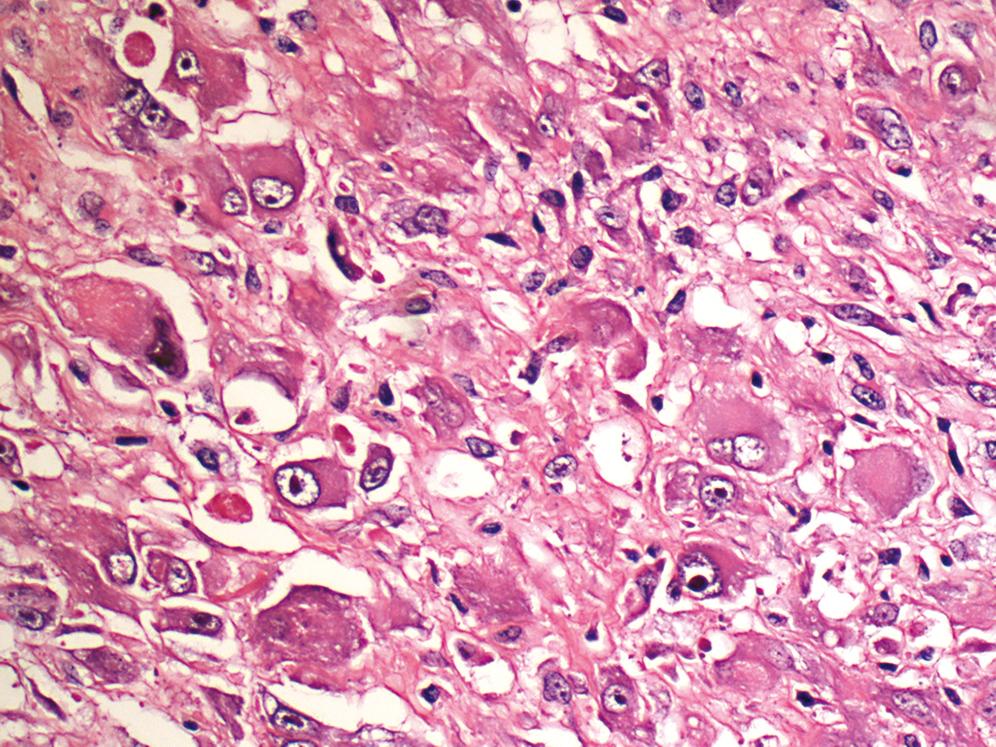
Ganglion-like cells are often nonreactive toward muscle markers and react with vimentin only
Noncontributory
Tumor of children, rarely seen in adults
Presence of rhabdomyoblasts rarely with cytoplasmic cross-striations
Immunoreactivity for desmin, muscle-specific actin (MSA), myogenin, and MyoD1
Intermixed neuroblasts and ganglion cells in a background of Schwannian spindle cell stroma
S100 protein is present in the Schwannian stroma
Tumor of young children; extremities an unusual location
Pathogenesis of proliferative fasciitis and myositis remains unexplained; fascial or muscular injury is thought to be a likely contributor
Benign, self-limited, reactive process treated with conservative surgical excision
Proliferative fasciitis and proliferative myositis are similar reactive proliferations that are best distinguished by their locations
Commonly affects young, athletic adults; usually involves the extremities
Uncommon in children
Presents as a solitary, tender mass; often associated with a history of trauma (>50% of cases)
Radiographic findings show characteristic zonal ossification, with rapid mineralization evident on sequential studies
Well-circumscribed, gray-yellow lesions with gritty areas
Some cases have central blood-filled spaces and are regarded as a variant of aneurysmal bone cyst occurring outside of bone ( Figure 17.3 )
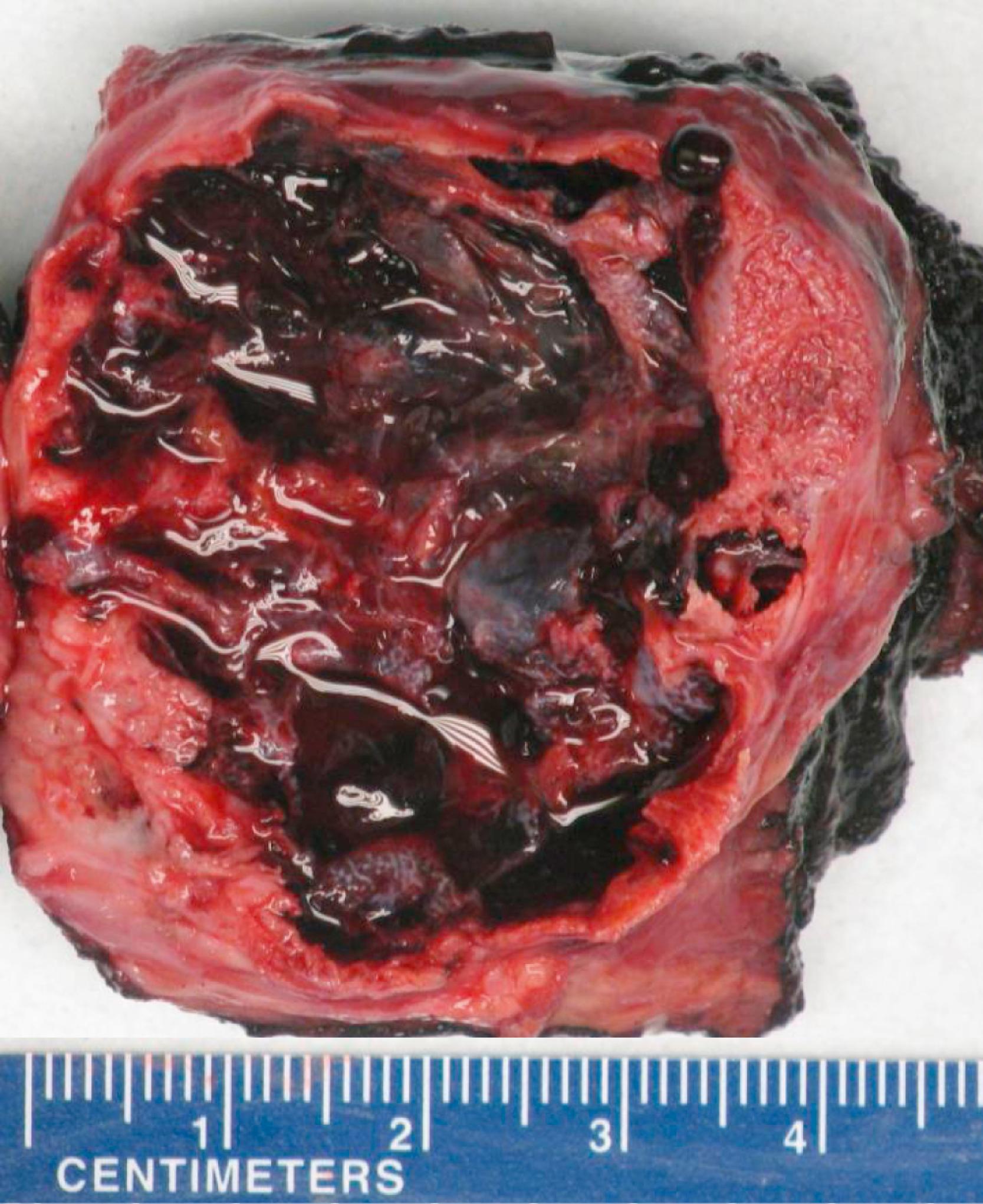
Typically shows a triphasic pattern with distinct zonation
Central cellular region
Resembles nodular fasciitis
Cells have bland nuclear features and a variable mitotic rate
Occasional multinucleated giant cells
Intermediate region is composed of immature osteoid
Peripheral zone is composed of mature, “purposeful” lamellar bone
Cartilage may be present
Noncontributory
USP6 translocation is detectible by fluorescence in situ hybridization (FISH) in some cases
Characterized by disordered growth of hyperchromatic, pleomorphic cells with delicate lacelike osteoid formation, often with faint bluish calcification
Absence of zonation
Chords and aggregates of plump spindle cells in a fibromyxoid matrix, with osteoblastic differentiation and bone formation generally around the outer rim of the tumor
Lacks inflammatory cells and granulation tissue appearance
Myositis ossificans is a benign, self-limited process with an excellent prognosis
Spontaneous regression can occur
A subset, likely those with USP6 translocation, have features of aneurysmal bone cyst
Also referred to as atypical decubital fibroplasia
Occurs over bony prominences or other pressure points in debilitated patients
Almost exclusively seen in late adulthood and rarely in younger patients
More commonly found in females
Poorly circumscribed, multinodular mass up to 10 cm in diameter
May have overlying ulceration
Typical zonation pattern
Central necrotic region
Liquefactive or coagulative necrosis with fibrin deposition ( Figure 17.4 )
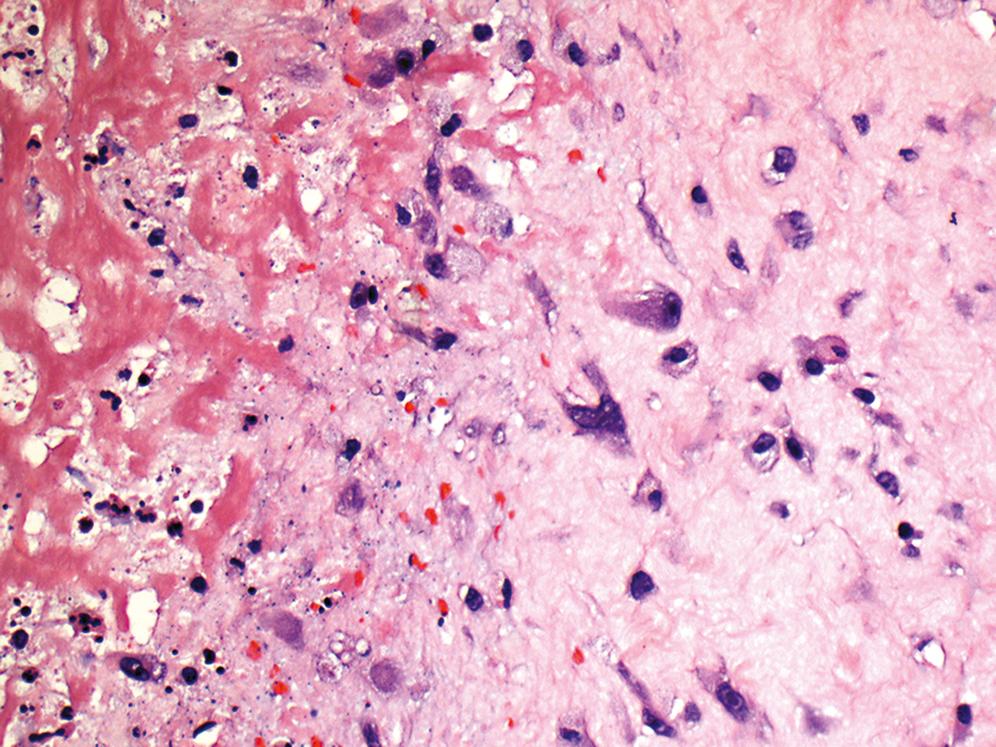
Peripheral fibroblastic and vascular proliferation
Granulation tissue-like with plump endothelial cells
Atypical fibroblasts with abundant eosinophilic cytoplasm and ganglion-like features
Vascular thrombosis and fibrinoid necrosis
Noncontributory
Noncontributory
Typical cases show scattered atypical cells present in adipose tissue with fibrous septa, which may resemble the reactive myofibroblasts in ischemic fasciitis
Myxoid change may be extensive, making adipocytic component difficult to find, especially in small samples
Fat necrosis is common, but not coagulative necrosis with fibrin
May produce a mass with a central cavity, adjacent to a joint
Cavity lining is generally denuded with fibrin exudate, and surrounded by inflammatory cells
Ischemic fasciitis is a benign, reactive process likely related to intermittent ischemia
Surgical excision is the treatment of choice; can recur owing to the persistence of the underlying cause
Usually presents as a deeply seated mass located in the lower subscapular area
Almost exclusively seen in late adulthood and rarely in younger patients
More commonly found in females
Firm, rubbery soft tissue mass with ill-defined margins
Cut surface is gray-white and glistening with entrapped foci of fat
Focal cystic degeneration often seen
Poorly defined lesion composed of thickened, coarse slightly basophilic elastic fibers and scant fibroblastic cells embedded in a heavily collagenized stroma ( Figure 17.5A )
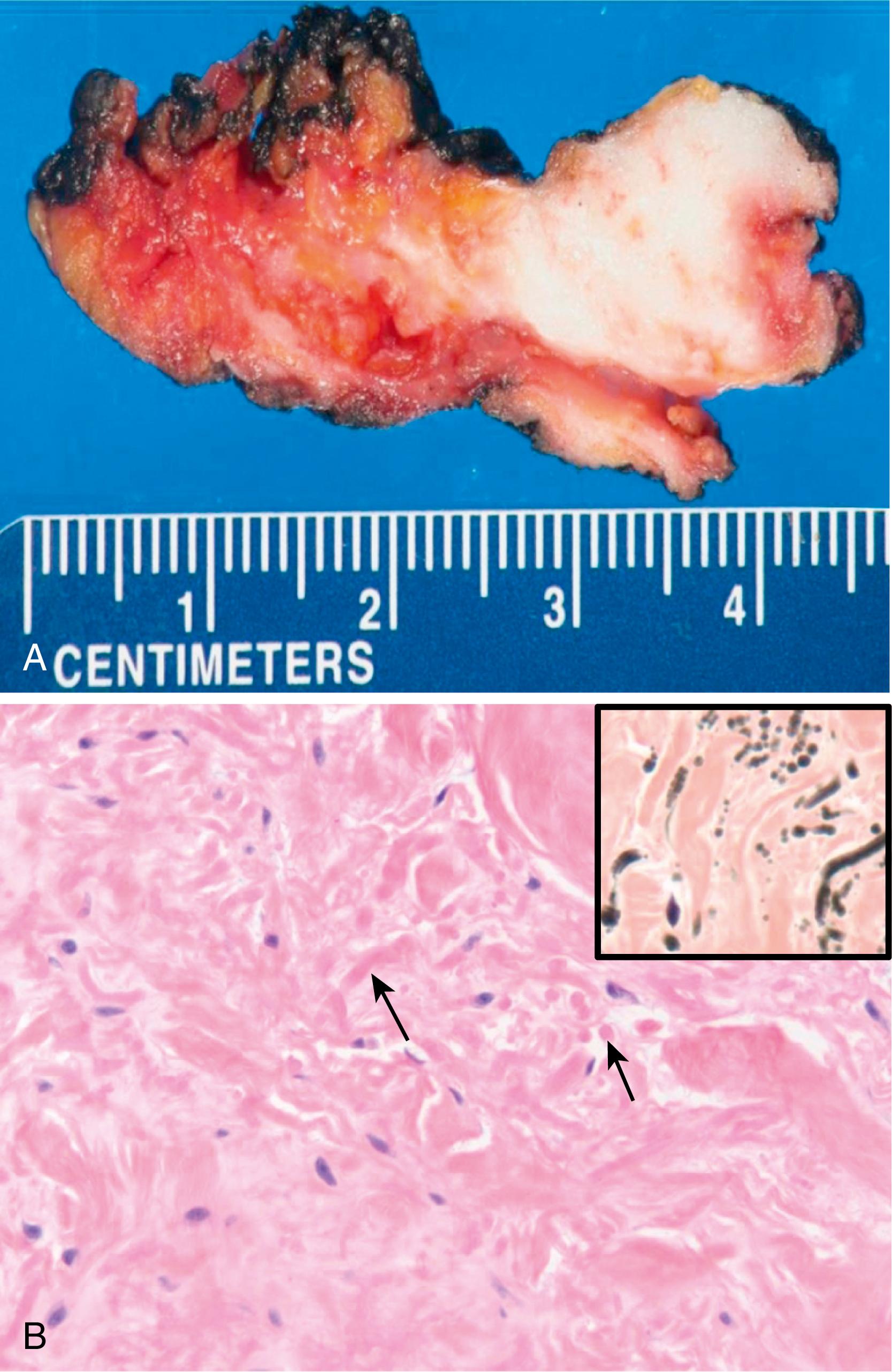
Entrapped mature adipose tissue is typically seen
Verhoeff–van Gieson elastic stain: highlights elastic fibers ( Figure 17.5B )
Noncontributory
Characterized by predominance of mature adipocytes with intervening fibrous connective tissue
Lacks elastic fibers
Subcutaneous mass in neck and shoulder region
Ropy collagen present, but not prominent elastic fibers. May show extensive myxoid change and contain few to no adipocytes
Histology of elastofibroma is described as “spaghetti and meatballs” owing to long and globular elastic fibers
Increased incidence in manual laborers; related to repetitive motion injury
Can usually be diagnosed by radiology or fine-needle aspiration
Presents as a small, slow-growing, subcutaneous nodule or thickening
Palmar fibromatosis (Dupuytren contracture)
Palmar surface of the hand; may result in contractures
Almost exclusively in adults, males affected more than females
Often bilateral, especially in alcoholics
Plantar fibromatosis (Ledderhose disease)
Plantar, non-weight-bearing area of the foot
Occurs in both children and adults
Often multinodular
Penile fibromatosis (Peyronie disease)
Dorsal aspect of the shaft of the penis
Exclusively seen in adults
Single or multiple, gray-white, firm nodules or scarlike tissue in the subcutis
Proliferative and involutional phases
Proliferative phase shows variably cellular fascicles of bland, spindled cells often arranged in a nodular pattern ( Figure 17.6 )
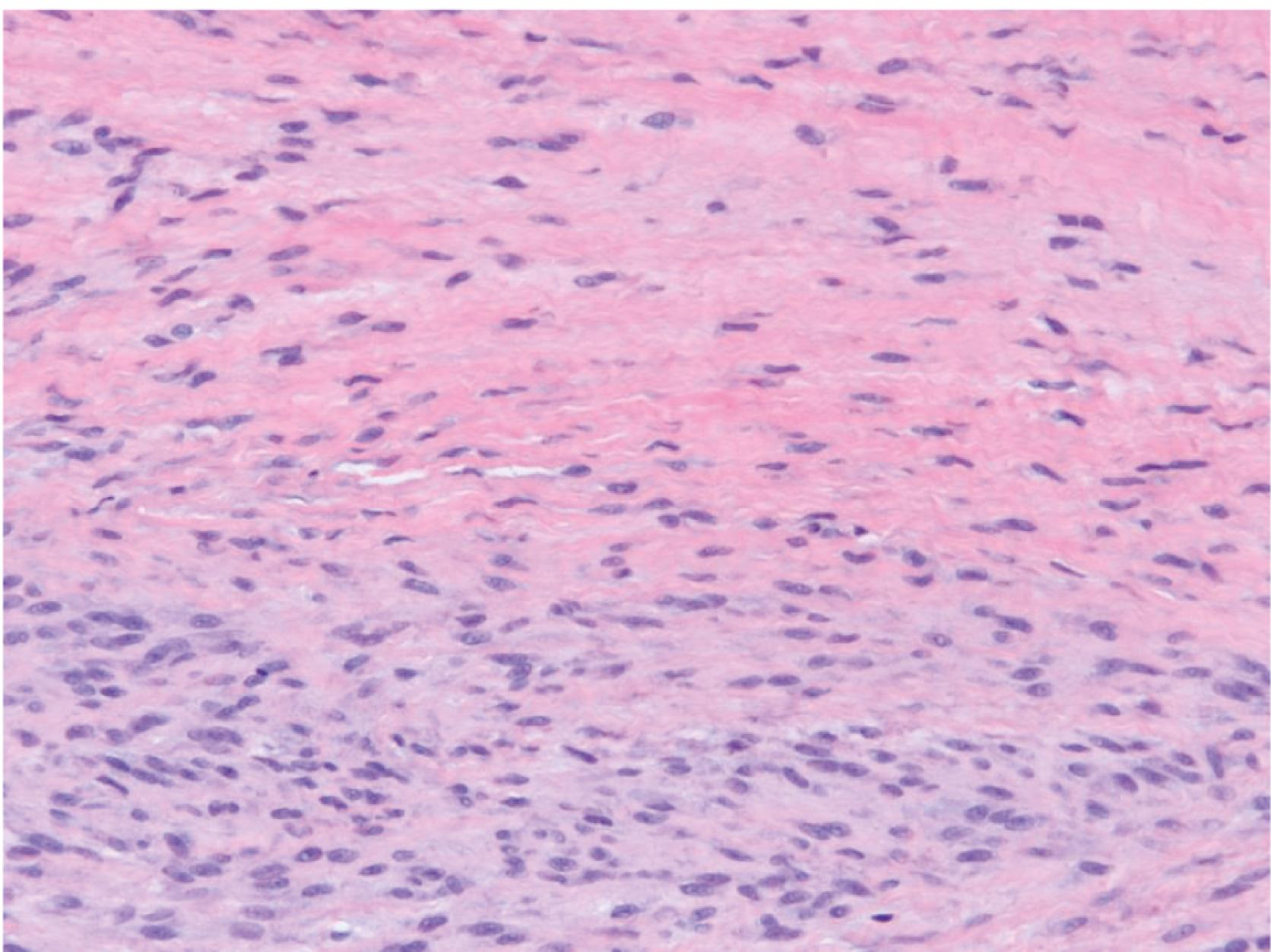
Occasionally prominent giant cells in plantar lesions
Mitotic figures may be seen
Involutional or residual phase shows paucicellular, densely collagenized tissue
Noncontributory
Noncontributory
Rare in hands and feet
Nuclear expression of beta-catenin is not helpful to distinguish between these entities
Well-circumscribed, sometimes multinodular mass firmly attached to tendon sheath
Hypocellular with bland spindle cells widely separated by hyalinized collagenous stroma
Infantile fibrosarcoma usually affects children younger than 1 year
Adult fibrosarcoma is only rarely found in distal extremities
Highly cellular, infiltrative tumor composed of uniform fibroblasts with hyperchromatic nuclei and scant cytoplasm, arranged in a distinctive herringbone pattern
High mitotic rate is common; atypical mitotic figures may be seen
Areas of necrosis or hemorrhage may be seen
Superficial fibromatosis may be multifocal
Plantar or palmar fibromatosis may be highly cellular and mistaken for sarcoma
Associated conditions may include diabetes, cirrhosis, and epilepsy; some fibromatoses may have a hereditary component
Surgical excision is the treatment of choice
Rapidly growing, painless subcutaneous mass in young children, sometimes congenital
Common sites include trunk, shoulder, axilla, and groin
Most cases occur within the first 2 years of life
Poorly defined deep dermal or subcutaneous mass
Gray, firm cut surface with yellow flecks
Usually 2 to 5 cm but may be larger
Triphasic appearance comprising an admixture of fibrous tissue, adipose tissue, and bundles of immature mesenchymal cells ( Figure 17.7 )
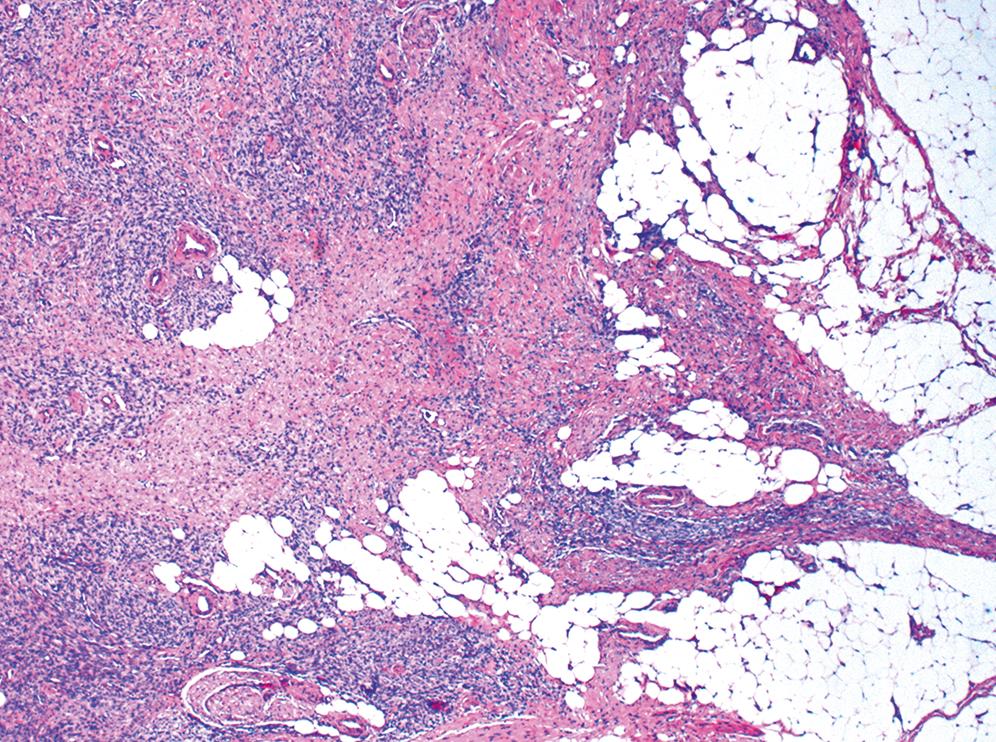
Often has a stellate configuration and infiltrates surrounding fat
Noncontributory
Noncontributory
Lacks a primitive mesenchymal component
Lobulated mass with fat lobules separated by fibrous bands
Lacks a primitive mesenchymal component
Myxoid stroma and lipoblasts are present
Lacks fibrous and adipose tissue
Positive for desmin, myogenin, and MyoD1
Fibrous hamartoma of infancy is a benign lesion usually cured with local excision
Previously referred to as infantile fibromatosis, nondesmoid type
Occurs in childhood, between birth and second decade; males affected more than females
Slowly growing, painless mass most commonly presenting in an extremity or on the trunk; rare cases in the head and neck
May cause isolated macrodactyly
Poorly defined subcutaneous mass with admixed adipose tissue
Usually 1 to 3 cm
Bands of bland spindled cells and collagen traversing through mature adipose tissue ( Figure 17.8 )
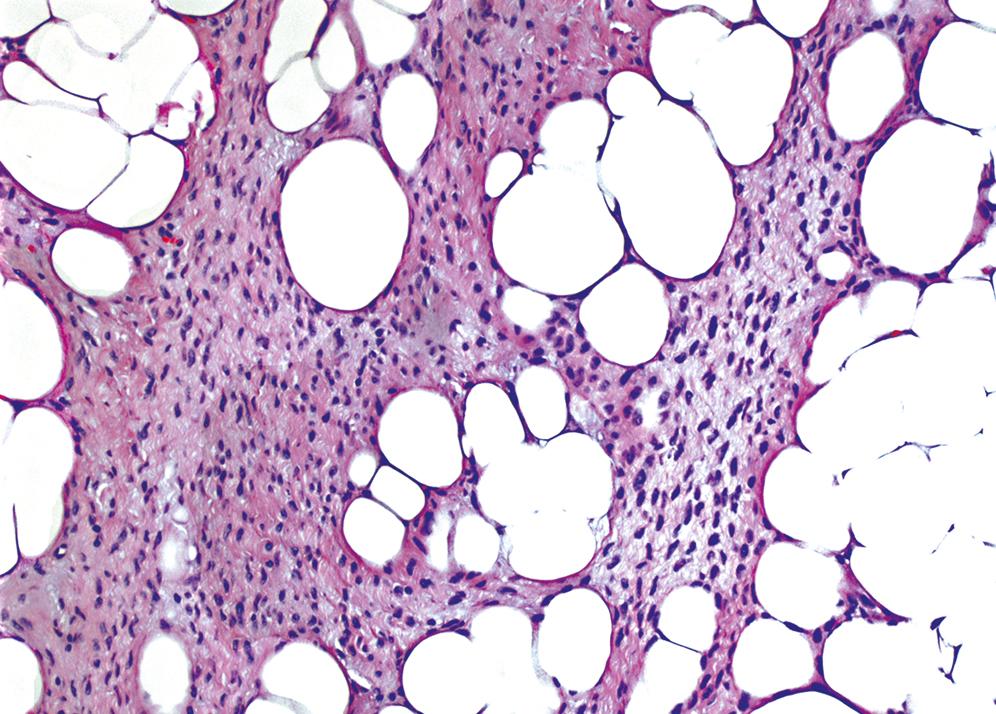
Infiltrative borders
Noncontributory
Noncontributory
Contains a primitive mesenchymal component
Lobulated mass with fat lobules separated by fibrous bands
Myxoid stroma and presence of lipoblasts
Contains moderately cellular areas of fibrous growth, which infiltrate into fat (or skeletal muscle); adipose tissue is not a primary component
Lipofibromatosis has a high rate of local recurrence but no metastatic potential
Wide local excision is the standard treatment
Also known as juvenile aponeurotic fibroma or Keasbey tumor
Most commonly affects children but may also occur in adults
Presents as a slow-growing, painless mass, usually on the palmar or plantar surfaces of the hands or feet, rarely in other locations
Poorly circumscribed, firm, gray-white, rubbery nodule usually smaller than 3 cm
Gritty cut surface
Bland oval plump fibroblasts in a heavily collagenized stroma
Foci of stippled to confluent amorphous calcifications surrounded by rounded chondrocyte-like cells ( Figure 17.9 )

Infiltrative margins with extension into adipose tissue
Osteoclast-like giant cells may be associated with calcification
Noncontributory
Noncontributory
Characterized by fascicles of spindled uniform-appearing fibroblasts with varying amount of collagen
Growth along fascial planes and tendons
Absence of calcification or chondroid differentiation
Usually found in adults, but plantar fibromatosis occasionally seen in children
Typically occurs in hands of adults
Characteristically a lobulated lesion composed of mature hyaline cartilage
“Chondroblastoma-like” variant undergoes calcification in a diffuse pericellular rather than in a focal manner
Calcifying aponeurotic fibroma is a locally aggressive lesion characterized by local recurrence (> 50% recur)
Younger lesions are less heavily calcified, and older lesions show more extensive calcification and chondroid differentiation
Surgical excision is the preferred treatment
Most commonly affects the hands of young to middle-aged adults; slight male predominance
Presents as a slow-growing, painless mass, usually on the preaxial digits or wrist but may affect foot or knee joint
Circumscribed, firm, gray-white, lobulated nodule attached to the tendon, usually smaller than 3 cm
Fibrous, often multinodular cut surface separated by clefts
Spindled to stellate cells embedded in a collagenous stroma, sometimes myxoid
Clefted, pseudovascular spaces separate the nodules ( Figure 17.10 )
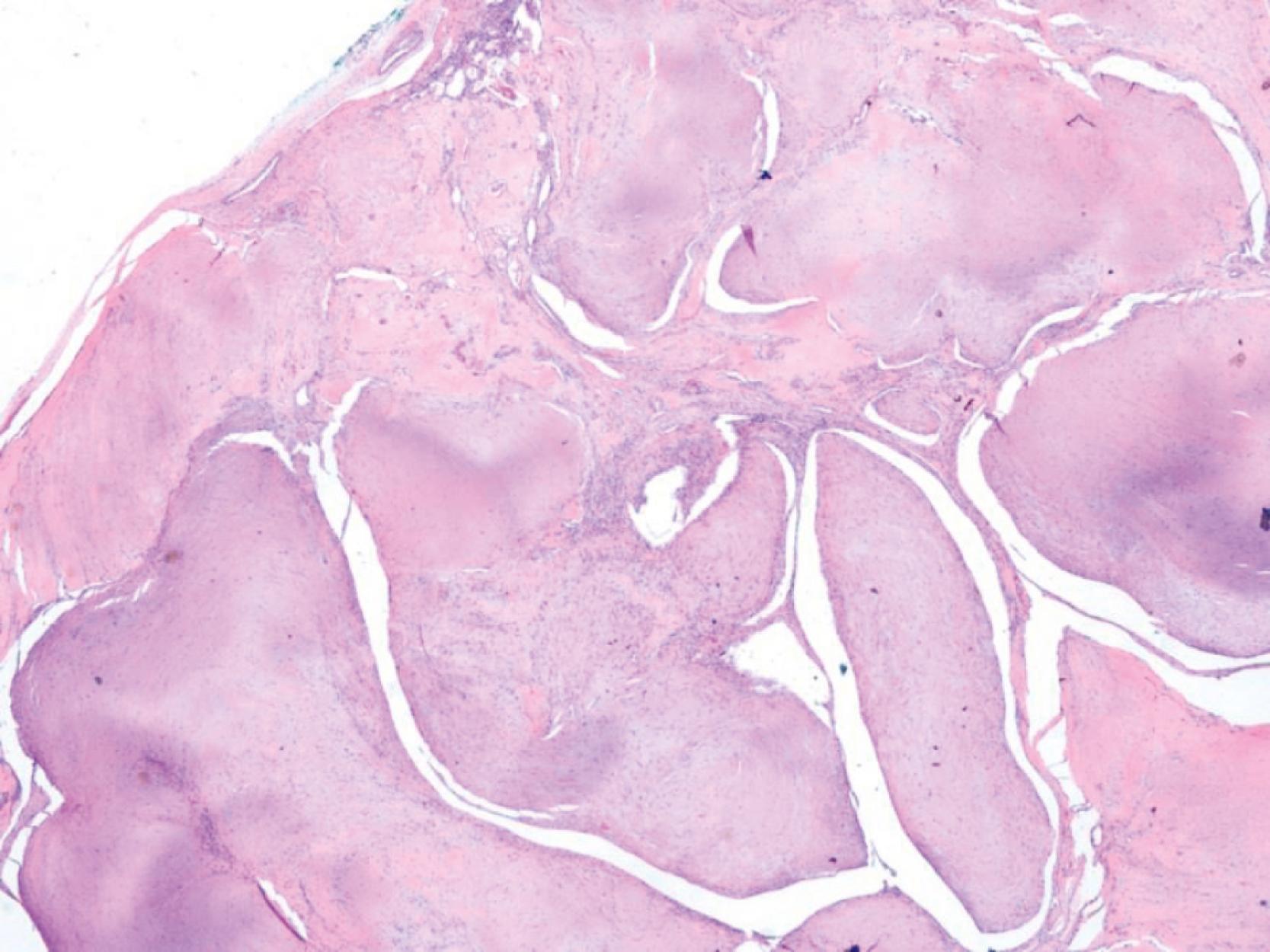
Degenerative cytologic atypia may be present; giant cells are rare
Noncontributory
Noncontributory
Numerous giant cells, plump mononuclear cells, and variable amounts of xanthoma cells
Growth along fascial planes and tendons with infiltrative borders
Fibroma of tendon sheath is benign and typically cured by surgical excision; recurrence is rare
Also known as desmoplastic fibroblastoma
Most commonly presents as slow growing painless mass in subcutaneous or deep tissues of upper extremities
The majority occur in late adulthood but can occur in childhood
Well-circumscribed mass, usually less than 5 cm ( Figure 17.11A )
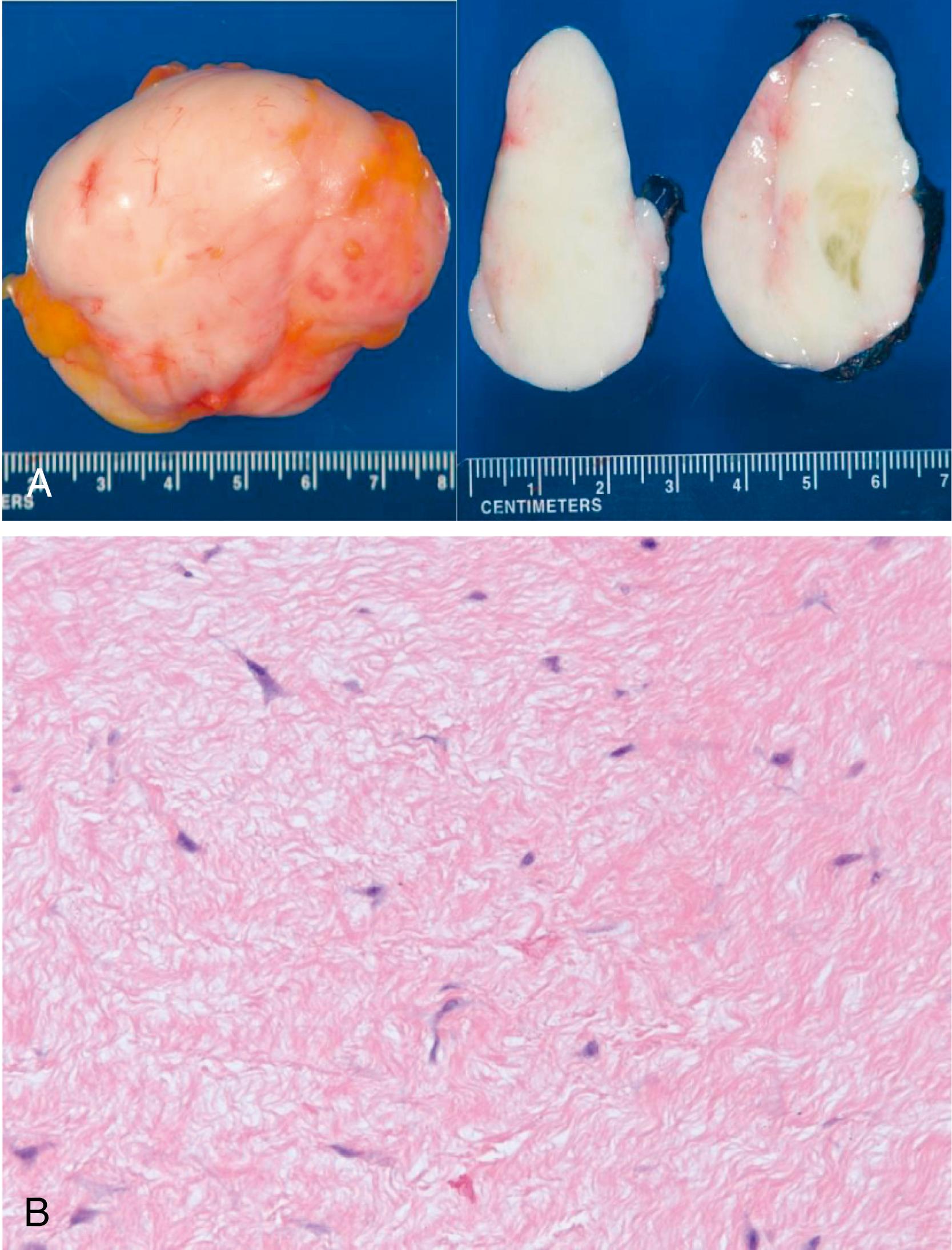
Cut surface gray-white with a lobulated or whorled appearance
Hypocellular spindle to stellate cell mass embedded in a loose collagenous stroma ( Figure 17.11B )
Mitotic figures are typically not seen
Noncontributory
Noncontributory
Typically seen in younger patients
Fascicular growth pattern with infiltrative borders that entrap connective tissues
Nuclear immunoreactivity for beta-catenin usually seen
Surgical resection is the standard treatment, typically does not recur
May have a genetic link to fibroma of tendon sheath
Also known as infantile congenital myofibromatosis or congenital myofibromatosis in children
Most common fibrous tumor of infancy
About 90% occur within the first 2 years of life; however, adults may be affected
Myofibroma refers to a solitary lesion (common), whereas myofibromatosis denotes multiple skin and soft tissue lesions with variable visceral involvement
Solitary subcutaneous nodules typically involve the head and neck but can occur anywhere
Multicentric form may involve the lungs, heart, bones, and gastrointestinal (GI) tract
Cut surface is rubbery gray-white with a lobulated or whorled appearance
May have central necrosis or cyst formation
Margins may be well defined or focally infiltrative
Size from 0.5 cm up to 8 cm
Typically shows a biphasic pattern or zonal phenomenon
Peripheral areas show fascicular or whorled growth of plump, spindled cells with eosinophilic cytoplasm (myofibroblasts)
Central areas of the lesion are more cellular with oval cells and a staghorn-appearing, hemangiopericytoma-like vasculature ( Figure 17.12 )

Variable mitotic activity but no atypical division figures
Scattered lymphoplasmacytic infiltrate typically present
Polypoid protrusion into vascular spaces is typical at the edge of the lesion
Focal areas of hemorrhage, calcification, and necrosis may be seen centrally
May be well circumscribed or infiltrative
SMA and MSA positive
Desmin variable
Immunohistochemistry does not help to exclude other myofibroblastic or smooth muscle proliferations
Noncontributory aside from ruling out other selected lesions such as infantile fibrosarcoma
Occurs in skin and subcutis of adults
Less cellular with more complete smooth muscle differentiation
Patients with solitary and multiple lesions of myofibroma or myofibromatosis confined to soft tissues have an excellent prognosis; visceral involvement imparts a worse prognosis depending on the particular locations and extent of growth
Bilateral symmetric bone lesions are a radiographic clue to diagnosis in infants
Lesions may spontaneously regress
Surgical resection is the standard treatment
Benign lesion of childhood and early adulthood that has a strong association with desmoid-type fibromatosis and familial adenomatous polyposis (Gardner syndrome)
Poorly defined, plaquelike soft tissue mass in superficial and deep tissues of back and paraspinal region, head and neck, extremities, and chest
Ill-defined firm mass with a white-gray, rubbery cut surface
Ranges in size from 1 to 12 cm
Sheets of densely hyalinized bundles of collagen containing scant, small spindle cells ( Figure 17.13 )
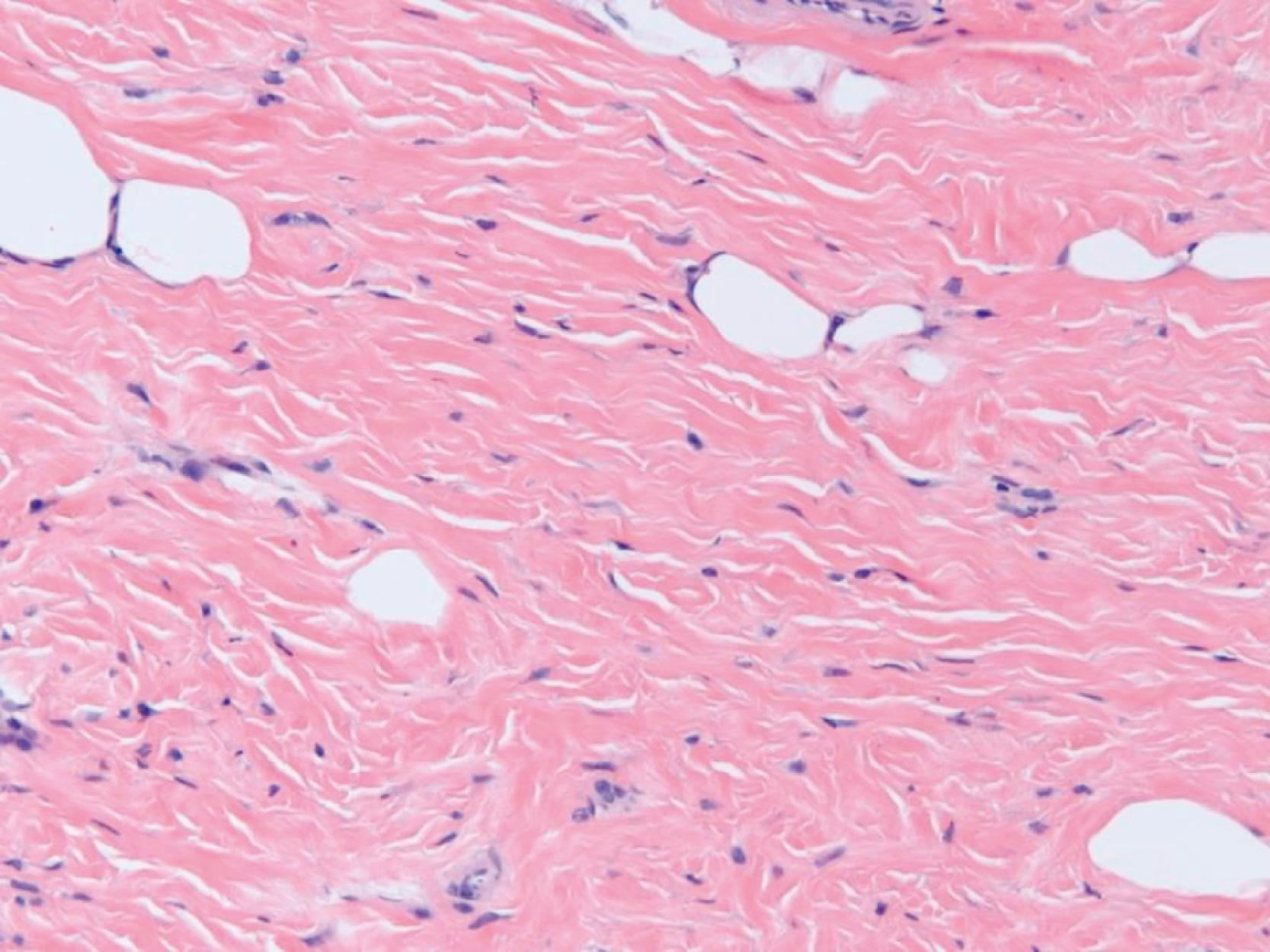
Collagen fibers are separated by cracks or clefts
Infiltrative borders are seen with entrapped connective tissue
CD34 positive
β-Catenin: most are positive with nuclear labeling
Noncontributory
More cellular spindle cell proliferation with fascicular growth pattern
Bundles of hyalinized collagen with entrapped adnexal structures and connective tissues
Frequently has proliferation of small nerves similar to traumatic neuroma
Distinct clinical presentation, occurs in the posterior neck of middle-aged adults (males affected more than females); associated with diabetes mellitus in about half of cases
CD34 and β-catenin stains typically negative
Densely eosinophilic elastic fibers intermixed with collagen as highlighted with the Verhoeff–van Gieson elastic stain
Occurs in older patients, frequently in subscapular location
Not associated with familial adenomatous polyposis
Gardner fibroma may be the first presentation of familial adenomatous polyposis (Gardner syndrome)
About half of patients will develop desmoid-type fibromatosis
Surgical resection is the standard treatment
Also referred to as aggressive or deep fibromatosis
Relatively common neoplasm that typically occurs in adolescents and young adults, but age range is wide
Comprises a group of proliferative tumors that present as deep-seated masses
Shoulder region, chest wall, thigh, and mesentery are favored sites
Musculoaponeurotic fibromatosis
Abdominal fibromatosis
Mesenteric fibromatosis
Lesions are associated intimately with muscular aponeuroses
Rectus muscle is the favored location
Occurs almost exclusively in women who are pregnant or postpartum
Found in mesentery of the bowel or retroperitoneum
Often associated with previous history of abdominal surgery
May be associated with Gardner syndrome (familial adenomatous polyposis, mesenteric fibromatosis, osteomas, and multiple epidermal inclusion cysts)
May appear well defined but actually has infiltrative margins
Often grows along fascial planes
Firm tumor that often has a gritty cut surface
Sectioning reveals a glistening, white, trabeculated surface
Composed of uniform-appearing, spindle-shaped fibroblasts and abundant collagen ( Figure 17.14 )
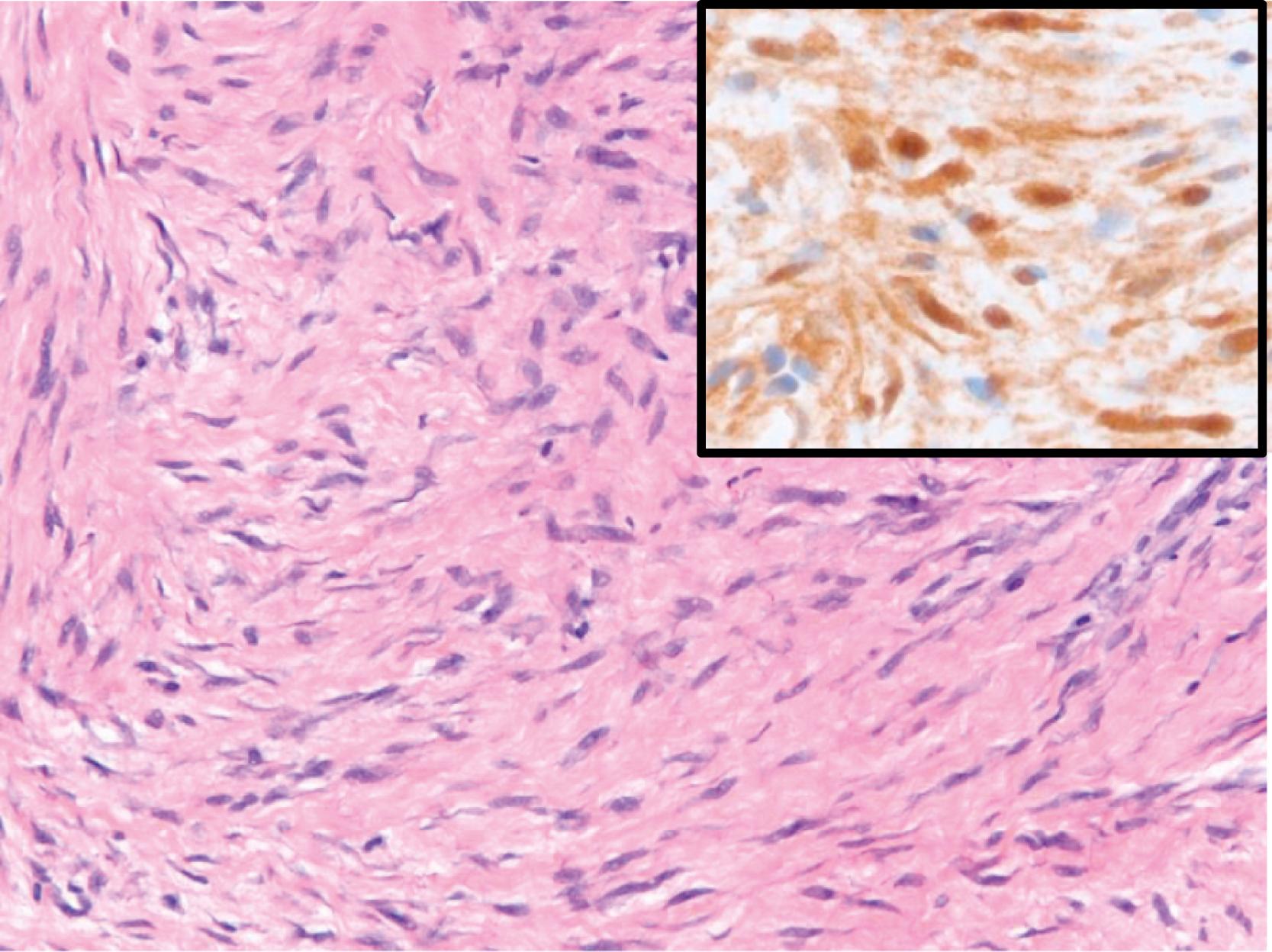
Infiltrative margins
Occasional mitotic figures are present in more cellular areas
Inconspicuous vasculature
Myxoid matrix may be seen, primarily in abdominal fibromatosis
β-Catenin: positive nuclear immunoreactivity
SMA positive
Recurrent chromosomal abnormalities include trisomies 8 and 20 and loss of 5q, not usually needed for diagnosis; CTNNB1 gene sequencing may identify mutations with prognostic relevance.
Alternating collagenized and myxoid zones with prominent curvilinear vessels
May contain hyaline collagen rosettes
Negative for nuclear β-catenin; positive for MUC4
Presence of t(7;16)(q33;p11), producing an FUS-CREB3L2 fusion in molecular or cytogenetic analysis
Most commonly affects children younger than 1 year; occasionally seen in adults
Highly cellular, infiltrative tumor composed of fibroblasts with hyperchromatic nuclei and scant cytoplasm arranged in a herringbone pattern
Mitoses are obvious, and atypical mitotic figures may be seen
Areas of necrosis or hemorrhage may be present
Infantile fibrosarcoma harbors t(12;15)(p13;q26), producing an ETV6-NTRK fusion demonstrable by molecular or cytogenetic studies
Desmoid-type fibromatosis has a high recurrence rate and may be locally aggressive but has no metastatic potential
Surgical removal is controversial for most cases due to high recurrence rate
Recurrence rate ranges between 25% and 80%
Benign fibrous tumor that occurs predominantly in adolescents and young adults
Most common in subcutaneous and deep soft tissues of extremities, trunk, groin, and neck but has been described in many locations, including viscera
Typically a circumscribed solid mass, 3 to 5 cm, but may be larger
Cut surface is solid, firm, and gray-white
Hypocellular, sclerotic tissue with a sparse lymphoplasmacytic infiltrate and discrete calcifications ( Figure 17.15 )
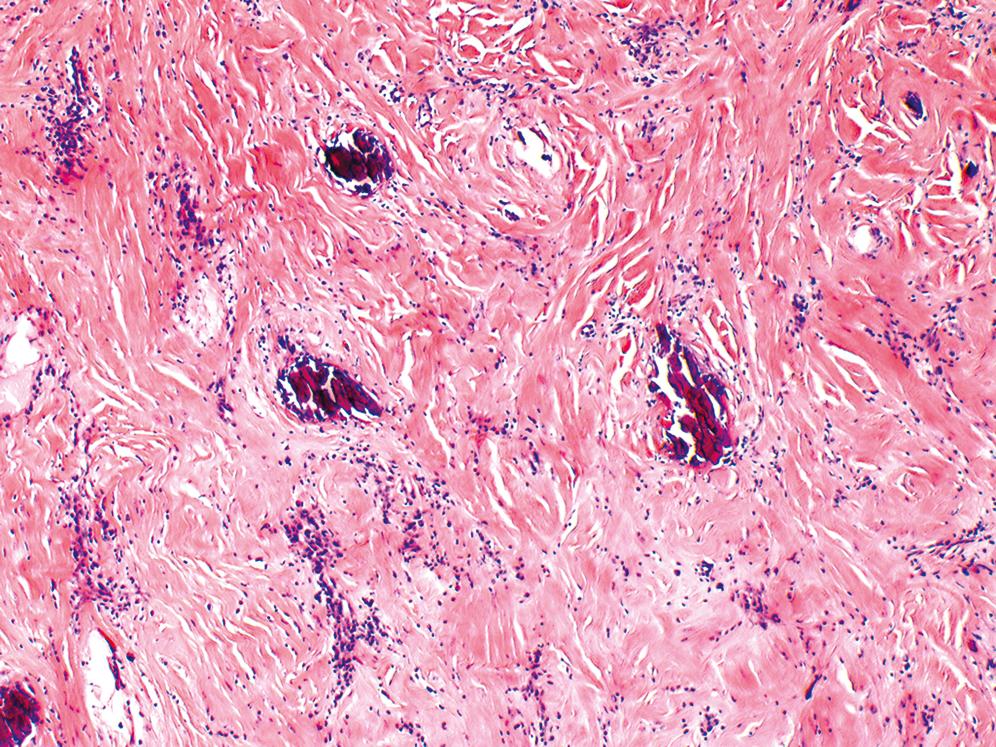
Calcification may be psammomatous or dystrophic
Germinal center formation may be seen at lesion periphery
Noncontributory
Noncontributory
Characterized by fascicles of spindle-shaped fibroblasts with varying amounts of collagen and infiltrative borders
More cellular than calcifying fibrous tumor. Lacks significant calcification
Positive for β-catenin nuclear reactivity in most cases
Typically seen on hands and feet of young children
Stippled calcification with surrounding chondroid differentiation
Infiltrative margins
Inflammation not typical
Calcifying fibrous tumor is a benign lesion with rare reports of recurrence
Treatment is complete surgical resection
Previously known as inflammatory pseudotumor and plasma cell granuloma
Most often occurs in children and young adults but has a wide age range
Commonly seen in the lung; the most frequent extrapulmonary sites are mesentery and omentum, but it can involve any location
Systemic symptoms and signs may be present, including fever, weight loss, anemia, increased erythrocyte sedimentation rate, and elevated C-reactive protein levels
Typically circumscribed, but nonencapsulated; often multinodular
Cut surface is solid, firm, and gray-white
Variably cellular tumor comprised of spindle cells and mixed inflammatory cells in a myxoid or collagenized background ( Figure 17.16 )
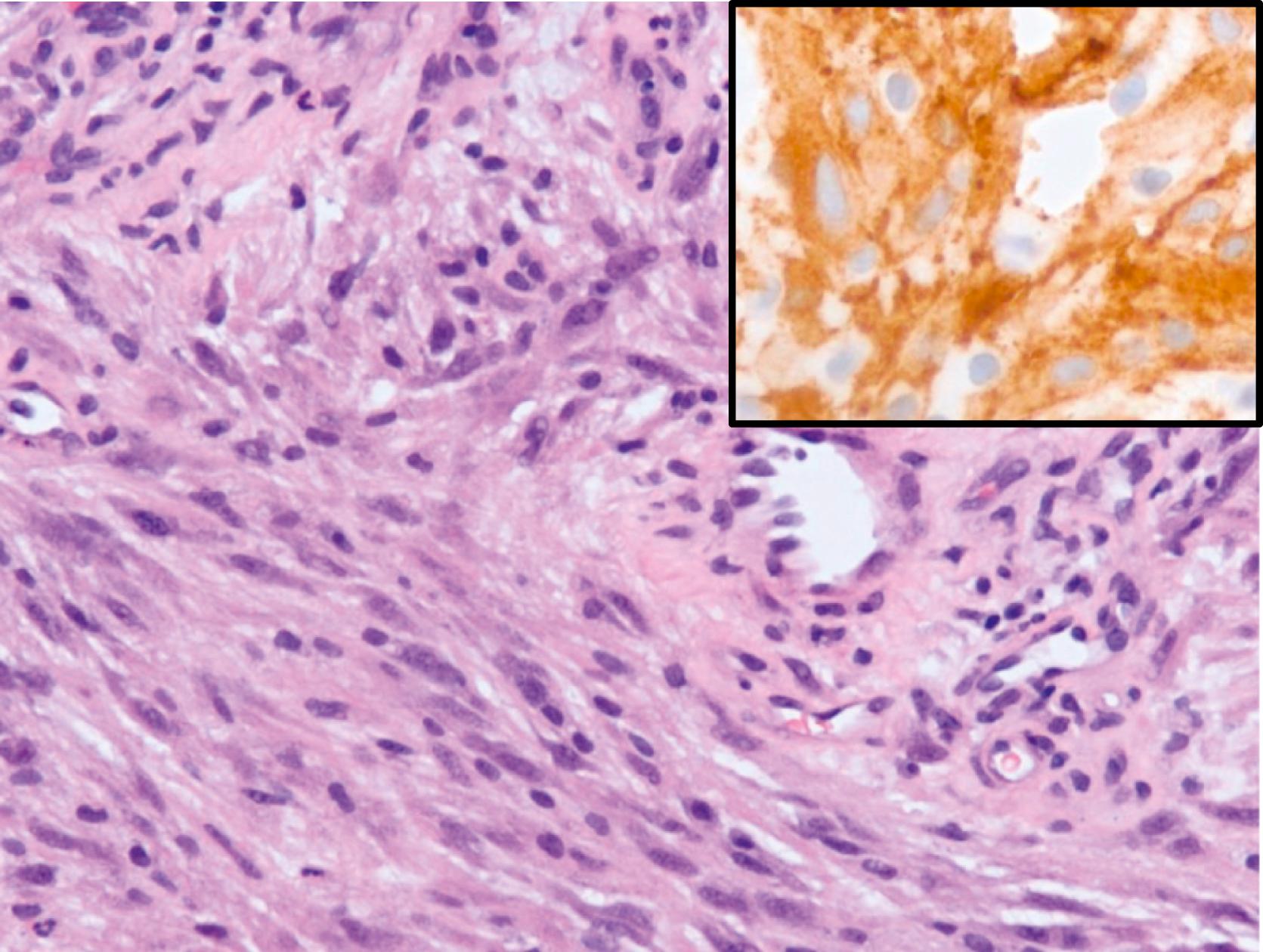
Some lesions contain large histiocytoid ganglion-like cells
May be hypocellular and resemble scars
Mitotic figures may be numerous
Variably positive for smooth muscle markers
ALK-1 protein present in about 40% of cases, more frequently in childhood tumors
Rearrangement of ALK locus at 2p23 by molecular or cytogenetic analysis
Characterized by fascicles of cytologically atypical spindle cells with hyperchromatic nuclei and variable but present mitotic activity
May have inflammatory infiltrate, usually patchy
Typically, middle-aged and elderly adults are affected
Fascicles of spindle-shaped fibroblasts with variable amounts of collagen and infiltrative borders
Positive for β-catenin with nuclear labeling in most cases
Lacks inflammatory infiltrate
Primitive spindle cells, usually in a myxoid background; focal strap cells may be present
Usually lacks inflammation
Positive for desmin, myogenin, and MyoD1
Usually occurs in older adults; retroperitoneum is the most common location
Cases with associated liposarcoma or MDM2 amplification are best classified as dedifferentiated liposarcoma
Atypical hyperchromatic cells with prominent mixed inflammation rich in xanthomatous cells
Negative for SMA and ALK-1
Usually supported by clinical history or imaging, with similar histology as primary
May have areas of squamous differentiation
At least focally positive for keratin, EMA, MOC31, or p63
Variably cellular spindle cell lesion with variable cellular pleomorphism, prominent nucleoli, and nuclear pseudoinclusions
May show perineural invasion extending beyond the tumoral component
Positive for S100 protein, Sox10; rarely for tyrosinase, Melan-A, or HMB-45
Inflammatory myofibroblastic tumor is a neoplastic process
Treatment is based on surgical resection
May recur after excision
Typically occurs in middle-aged adults but has a wide age range
Includes cases previously called hemangiopericytoma (except nasal type)
Presents as a localized, slow-growing, painless mass
Most commonly involves the pleura; extrapleural sites include subcutaneous and deep soft tissues, orbit, retroperitoneum, mediastinum, pericardium, and other locations
Ranges in size from 1 to 27 cm
Typically well circumscribed with a firm, tan-white cut surface; sometimes multinodular
Focal necrosis, hemorrhage, and cystic degeneration may be seen
Characterized by uniform spindle cells haphazardly arranged in a collagenized background ( Figure 17.17 ); collagen focally surrounds individual cells
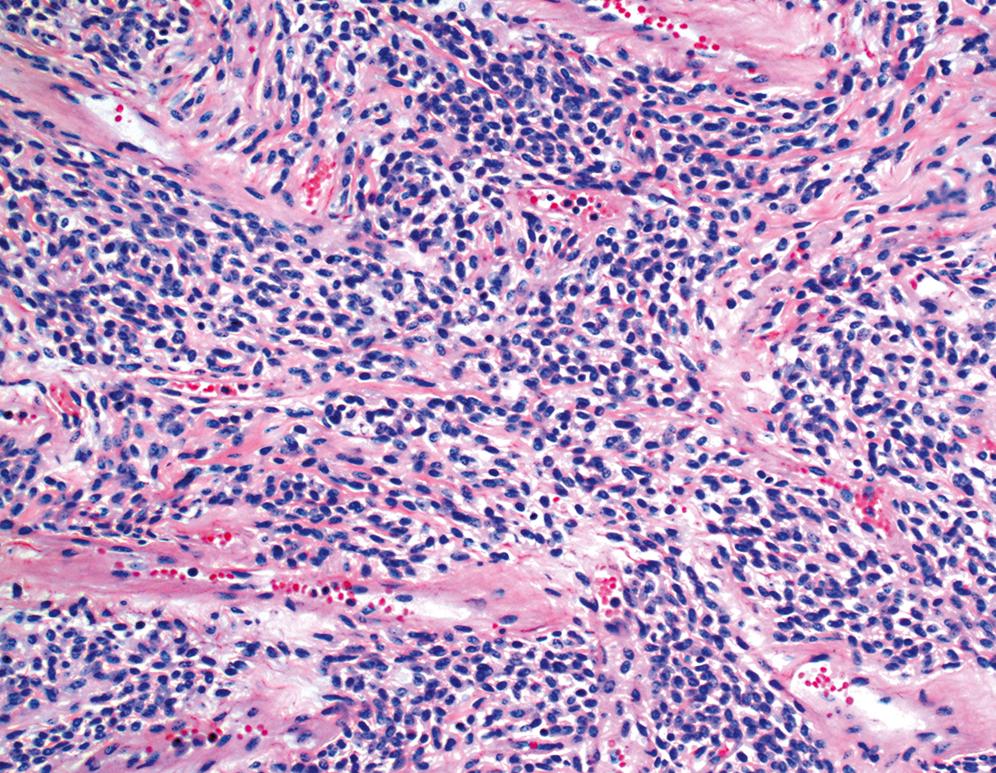
Hypercellular and hypocellular, collagenous areas (so called “patternless pattern”)
“Hemangiopericytoma-like” open, staghorn-shaped, and hyalinized blood vessels
Epithelioid areas may be present
Low mitotic activity (<4 mitotic figures/10 high-power fields)
Criteria for malignancy include dense cellularity, numerous mitotic figures, obvious cytologic atypia, necrosis, and infiltrative growth; “dedifferentiation” (transformation to high-grade sarcoma) has been reported
CD34 positive in about 85% of cases, CD99 and bcl-2 positive in about 75% of cases
Nuclear immunoreactivity for STAT6 in 98% of cases
STAT6 staining may be lost with transformation to high grade
Genomic inversion at 12q13 leading to fusion NAB2-STAT6 in majority of cases
Lipomatous area may not be appreciated if incompletely sampled
Shows MDM2 and CDK4 amplification/expression. Lacks STAT6 translocation, but may show STAT6 expression
Monophasic spindle cell or biphasic spindle cell and epithelioid tumors with high nuclear-to-cytoplasmic ratios
Herringbone growth pattern is common, but areas may resemble solitary fibrous tumor (SFT)
Mitotic activity is usually easily seen
Intratumoral calcifications and metaplastic bone are sometimes present
Immunoreactive for keratin or TLE1, EMA, CD99, and bcl-2; CD34 negative
Solitary fibrous tumor can occur at any location
Has “patternless pattern” of spindle cells with hemangiopericytoma-like vasculature
Usually behaves in an indolent manner but may recur or metastasize even if histologically banal; borderline tumor
Surgical resection is the preferred treatment
Hemosiderotic fibrolipomatous tumor (HFLT; also known as hemosiderotic fibrohistiocytic lipomatous lesion ) and myxoinflammatory fibroblastic sarcoma (MIFS) are discussed together due to their clinicopathologic and molecular similarities; hybrid tumors have been reported
Presents as a localized, slow-growing, infiltrative mass of the distal extremities
HFLT is most common in the subcutis of the dorsum of the foot and ankle
MIFS is usually on the hands and is locally infiltrative into synovium and tendons
Adults are affected more often than children, and HFLT is more common in women
Ranges in size from 1 to 20 cm and has infiltrative borders
Tan to yellow cut section but may be gelatinous or fatty; hemorrhage may be present
HFLT is characterized by spindle cells admixed with mature adipose tissue
Abundant hemosiderin-laden macrophages and scattered inflammatory cells are present in the spindle cell component ( Figure 17.18A )
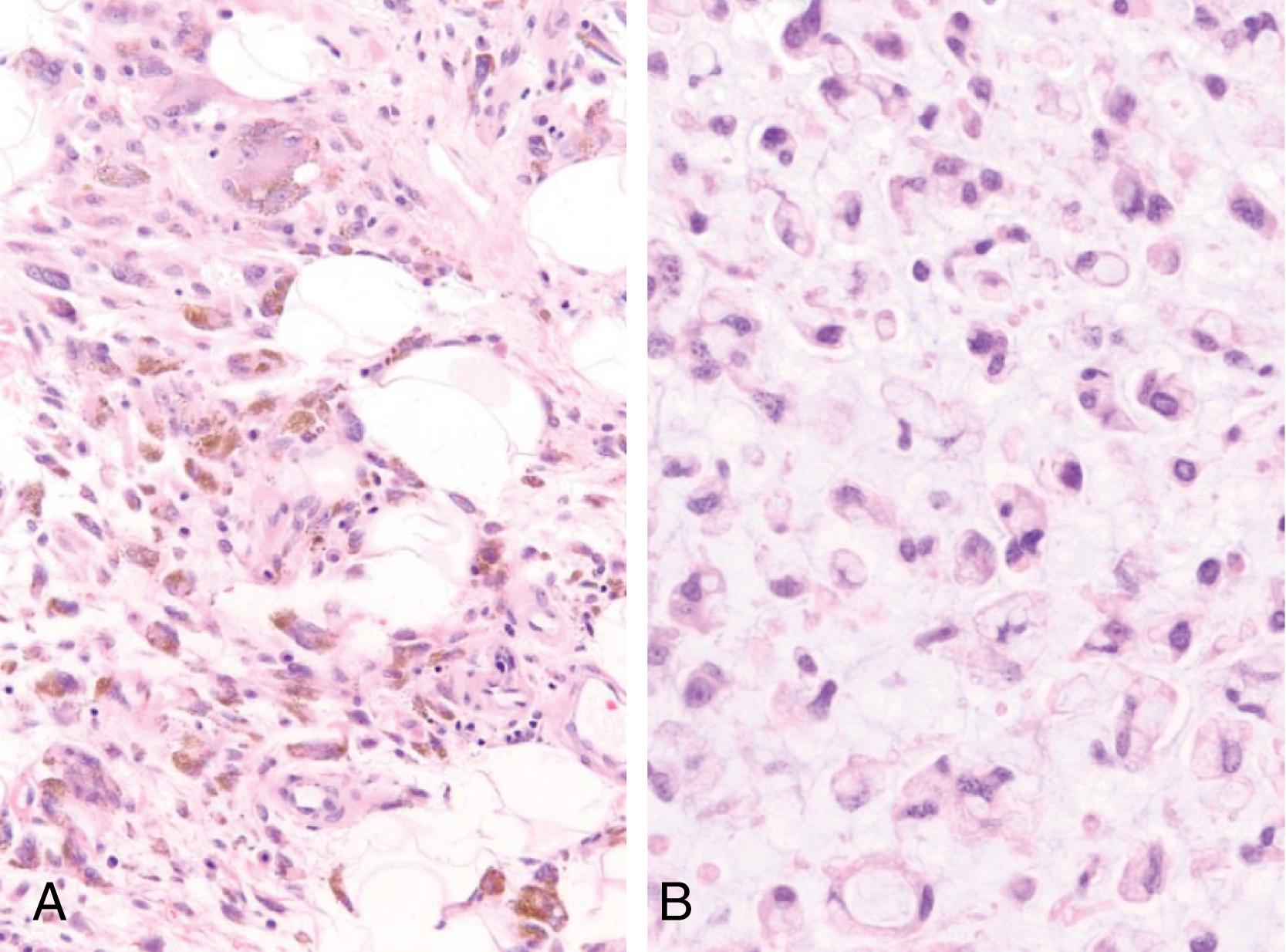
MIFS is heterogenous with a myxoid component containing pseudolipoblasts, neutrophils and lymphocytes, and a bland spindle cell proliferation ( Figure 17.18B )
Large ganglion celllike or Reed-Sternberg–like cells with prominent nucleoli are present in MIFS
Low mitotic activity (<3 mitotic figures/10 high-power fields)
CD34 immunoreactivity in the spindle cell component in both HFLT and MIFS
SMA, desmin, and S100 are negative
Presence of t(1;10) (p22;q24) producing a TGFBR3-MGEA5 fusion has been reported in both HFLT and MIFS (as well as pleomorphic hyalinizing angiectatic tumor)
Presents in the retroperitoneum and deep soft tissues of proximal extremities
Typically lacks prominent spindle cell component; variation in size of adipocytes and lipoblasts may be present
Morphology of dedifferentiated, inflammatory areas resemble MIFS
The large hyperchromatic nuclei in scattered cells of typical atypical lipomatous tumor (ALT) lack prominent nucleoli
Lacks prominent hemosiderin deposition
MDM2 and CDK4 amplification and expression
Usually occurs in older adults; retroperitoneum is the most common location
Some cases best classified as dedifferentiated liposarcoma if associated liposarcoma or MDM2 amplification is found
Atypical hyperchromatic cells with prominent mixed inflammation rich in xanthomatous cells
Dermal/subcutaneous mass in the extremities of young adults
Distinct nodules composed of mononuclear histiocytoid cells, osteoclast-like giant cells, and fibroblasts in whorls or fascicles
Hemorrhage may be present
Usually more proximal extremity
Lacks granulation tissue-like areas with dense inflammatory cell infiltrate
HFLT and MIFS are genetically linked tumors
Considered benign but locally aggressive, with up to a 50% recurrence rate
Metastasis is rare and more common in those with MIFS histology, and dedifferentiation of HFLT has been reported
Also known as Evans tumor. One variant originally termed “hyalinizing spindle cell tumor with giant rosettes”
Typically seen in young adults but can occur in children and elderly
Deep soft tissue mass most often in proximal extremities or trunk
May be present for several years before diagnosis
Usually a large and nonencapsulated but well-circumscribed mass
Cut surface is firm, white, or tan, sometimes with a myxoid appearance
Bland fusiform cells with variably collagenous to myxoid stroma ( Figure 17.19 )

Collagenized areas are arranged in short haphazard fascicles
A whorling growth pattern, myxoid nodules, and a prominent arcade of hyalinized vessels may be present
Rosettes may be present, characterized by hyalinized nodules cuffed by tumor cells
Mitotic figures are absent or sparse
May be seen as a hybrid with sclerosing epithelioid fibrosarcoma or less commonly with an undifferentiated round cell component
Immunoreactive toward MUC4
Variably positive for EMA, SMA, desmin, and CD34
Presence of t(7;16)(q34;p11), producing an FUS-CREBL2 fusion, can be demonstrated by cytogenetic or molecular analysis in most cases
May be indistinguishable on routine morphology, especially in small samples
Usually shows nuclear beta-catenin
Lacks MUC4 expression and FUS-CREBL2 fusion
Lipomatous area may not be appreciated if incompletely sampled
Shows MDM2 amplification
Less cellular overall than low-grade fibromyxoid sarcoma (LGFMS)
Less collagenous, even in most fibrous areas
GNAS mutations present, as in typical myxoma
Almost exclusively myxoid with prominent thin-walled vessels
Mild cytologic atypia and pseudolipoblasts
Older patients
Lacks zonation
Slender, wavy nuclei with tapered ends
Positive for S100 protein, CD56, and CD57
Recurrence is common if incompletely excised
Metastatic rate varies widely in case series reports, with average interval of 5 years, and up to 45
Also known as myofibrosarcoma
Distinctive low-grade tumor with myofibroblastic differentiation
Tumor of middle-aged adults, rarely reported in children
Most commonly involves head and neck
Firm mass with white cut surface and poorly defined margins
Moderately cellular spindle cell lesion arranged in fascicles and whorls ( Figure 17.20 )
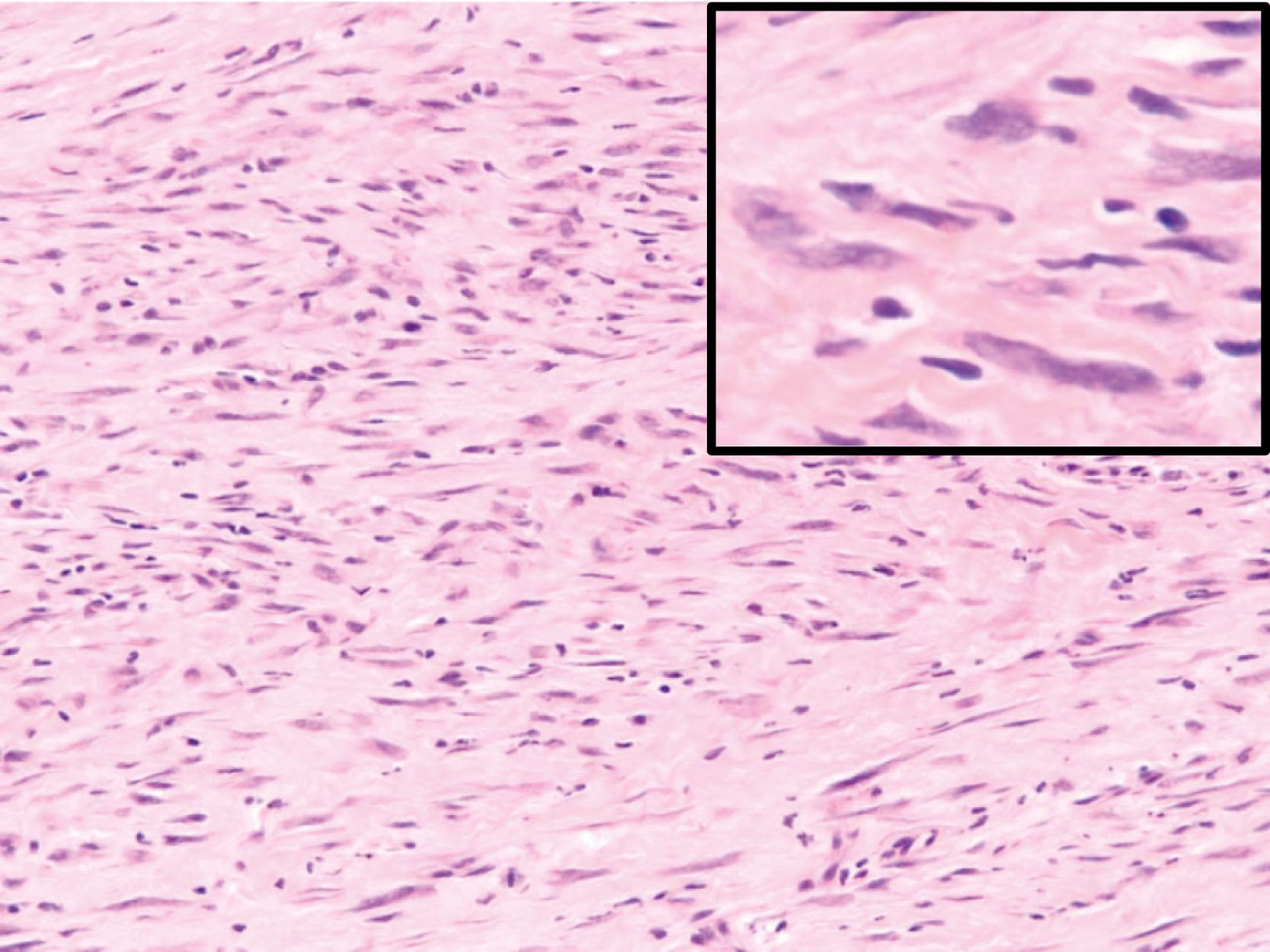
Modest nuclear hyperchromasia and mild cellular pleomorphism
Infiltrates adjacent tissues
Mitotic figures are variable in number
Desmin, MSA, SMA: at least one is positive
Noncontributory
Lacks cellular pleomorphism
Positive for β-catenin with nuclear labeling in most cases
Hypocellular myxoid areas and collagenized foci
Possible presence of hyalinizing rosettes
Presence of t(7;16)(q34;p11), producing an FUS-CREBL2 fusion, is characteristic
Wide surgical resection is necessary for low-grade myofibroblastic sarcoma
Local recurrence is common; metastases are rare but may be seen after many years
Occurs primarily in children younger than 2 years; about 25% are congenital
Most common on extremities, followed by trunk and head and neck
May mimic a vascular lesion both clinically and radiographically; large “hemangiomas” in young children should undergo biopsy if they enlarge
Infiltrative borders
Firm, fleshy, lobulated mass, often large
Cut surface is gray-white to tan-yellow
Cellular tumor is characterized by apposed, spindle-shaped fibroblasts arranged in interlacing fascicles or a herringbone pattern ( Figure 17.21 )
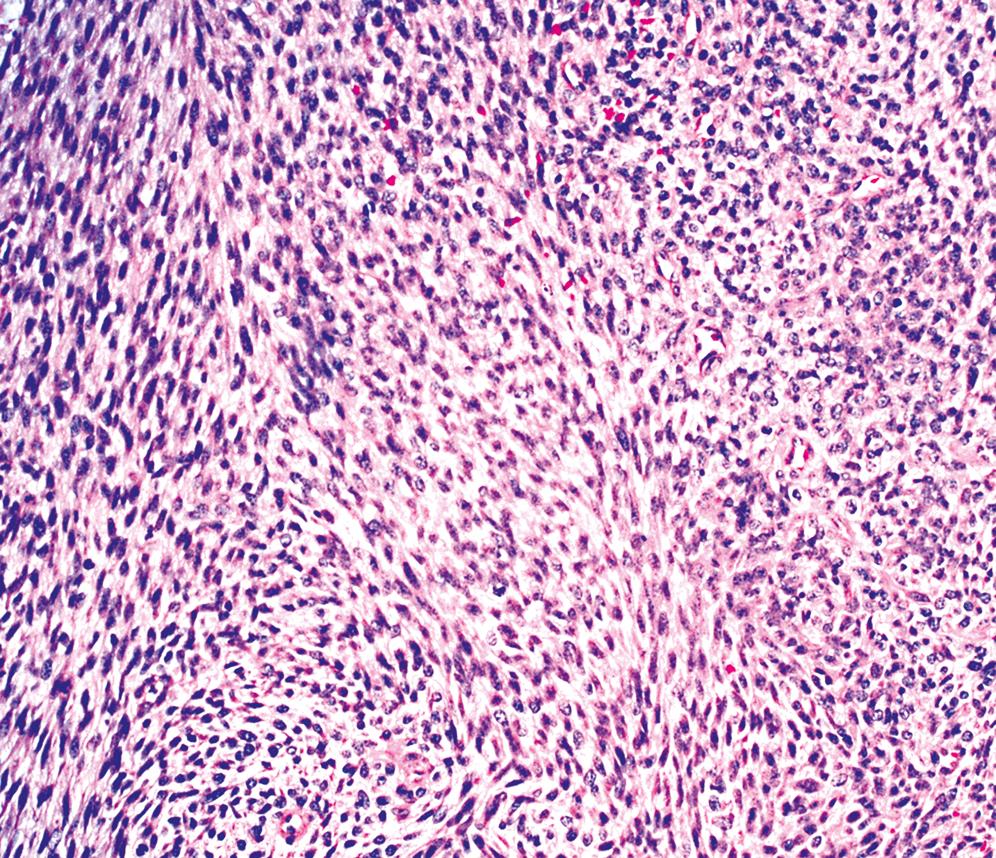
Frequent mitotic activity is seen, sometimes with atypical forms
Necrosis and hemorrhage are common
Myxoid or collagenous stroma may be seen
May have focal hemangiopericytoma-like vasculature
Scattered chronic inflammatory cells and focal extramedullary hematopoiesis are seen
Negative for epithelial, muscle, and neural markers as well as CD34, bcl-2, and CD99
Up to 90% of cases have t(12;15)(p13;q26) that creates a fusion gene, ETV6-NTRK3 ( TEL-TRCKC ): this may be cryptic on conventional karyotyping and requires reverse transcription polymerase chain reaction or fluorescent in situ hybridization studies
Infantile fibrosarcoma may contain foci indistinguishable from those of myofibroma; shows more cellular and atypical areas as well
Biphasic areas of cellular density
Possible intravascular polypoid projections
Usually paratesticular when seen in children
Possible presence of strap cells
Positive for desmin, myogenin, and MyoD1
Wide surgical excision is the preferred treatment for infantile fibrosarcoma
Chemotherapy is reserved for unresectable tumors
About 15% to 30% of cases recur, but metastases are rare
Presence of t(12;15) is also seen in cellular mesoblastic nephroma of the kidney and secretory carcinoma
Rare tumor of middle-aged to elderly adults
Located in deep tissue of extremities, trunk, or head and neck; rarely other locations
A similar histologic pattern is seen in transformation of dermatofibrosarcoma protuberans
May be seen as a post-irradiation neoplasm
Firm, lobulated mass usually 3 to 10 cm in diameter
Small tumors may be well circumscribed
Cut surface is gray-white to tan-yellow with hemorrhage or necrosis
Variably hyperchromatic spindle cells with eosinophilic or amphophilic cytoplasm, may show a herringbone growth pattern
Variable mitotic activity
Lacks significant pleomorphism
Negative for epithelial, muscle, and neural markers as well as CD34, CD99, bcl-2, STAT6, and nuclear β-catenin. Preserved expression of H3K27me2
Noncontributory except to rule out other tumors, especially monophasic synovial sarcoma t(X;18)
Lacks dense cellularity, nuclear hyperchromasia, and herringbone growth
No hemorrhage or necrosis
Positive for nuclear β-catenin in most cases
May have herringbone or hemangiopericytoma-like growth patterns
Commonly shows areas of hypercellularity and hypocellularity
Immunoreactivity for cytokeratin, EMA, TLE1, CD99, bcl-2, and CD57
Presence of t(X;18); SYT translocation by FISH
Composed of elongated cells with variably pleomorphic, wavy nuclei
Cells arranged in fascicles or whorls; possible formation of neural tactoids
Nuclear palisading sometimes seen
May be positive for S100 protein, glial fibrillary acidic protein (GFAP), and CD56, or may show loss of H3K27me3 and H3K27me2
May be seen de novo through the clonal evolution of well-differentiated liposarcoma
Dedifferentiated areas may mimic fibrosarcoma, but extensive sampling usually reveals low-grade adipocytic component
Most commonly occurs in the retroperitoneum
MDM2 and CDK4 amplification and expression detected
Alternating hypocellular myxoid areas and collagenized spindle cell foci
Lacks herringbone grown pattern
Presence of t(7;16) or FUS rearrangement by FISH
Wide resection, with or without adjuvant radiotherapy, for adult fibrosarcoma is standard therapy; chemotherapy may be indicated for high-grade tumors
Fibrosarcoma is a pathologic diagnosis of exclusion and likely makes up less than 1% of sarcomas
Distinctive variant of fibrosarcoma
Tumor of middle-aged adults, but has been reported in children
Common locations include deep soft tissue of extremities, trunk, chest wall, or head and neck; may be painful
Firm, oval, or lobulated soft tissue mass ranging in size from 2 to 20 cm
Cut surface is gray-white; may have myxoid or cystic areas
Nests or cords of uniform, round to oval tumor cells with eosinophilic to clear cytoplasm embedded in a densely hyalinized stroma ( Figure 17.22 )
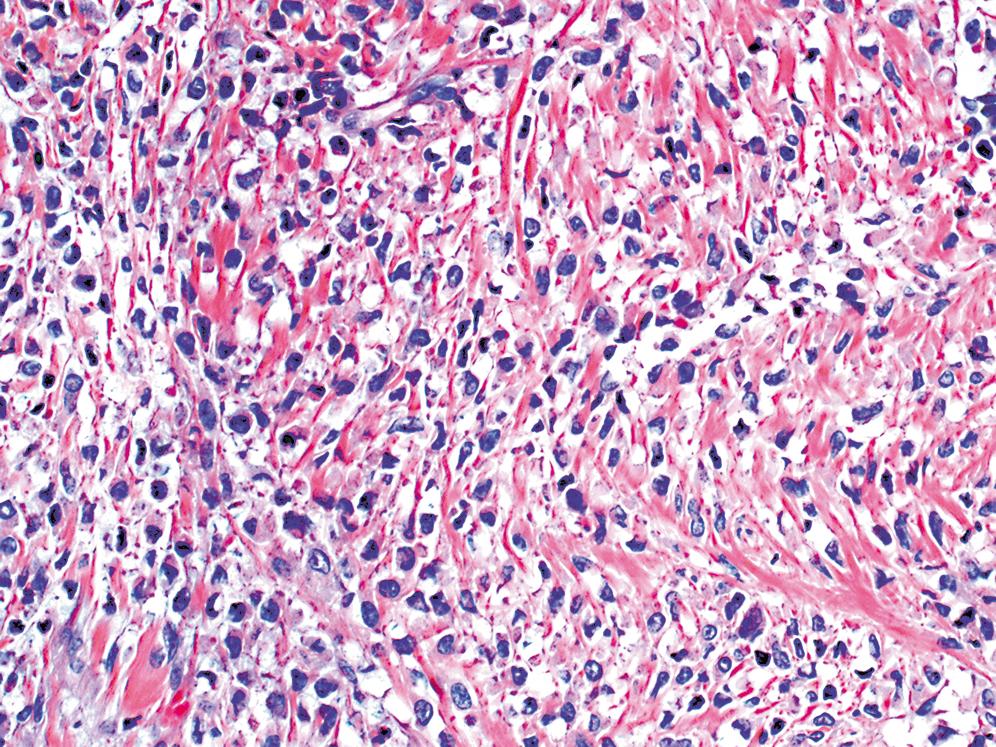
May have fascicular, myxoid, or cystic areas and hemangiopericytoma-like vasculature
Mitotic figures are infrequent
Some cases have an associated low-grade fibromyxoid sarcoma
Most cases are positive for MUC4, variably for EMA. Typically negative for cytokeratins
Become a Clinical Tree membership for Full access and enjoy Unlimited articles
If you are a member. Log in here